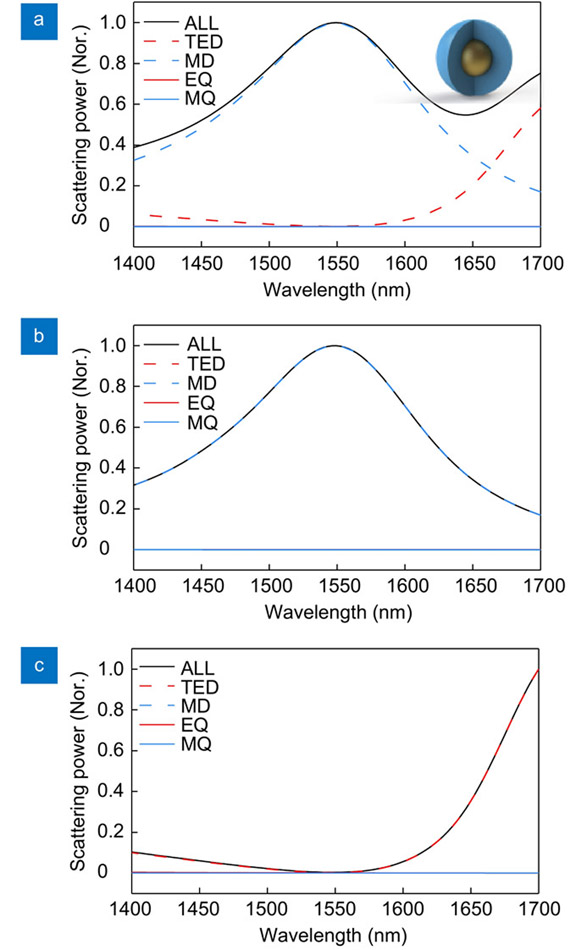Yudong Lu, Yi Xu, Xu Ouyang, Mingcong Xian, Yaoyu Cao, Kai Chen, Xiangping Li. Cylindrical vector beams reveal radiationless anapole condition in a resonant state[J]. Opto-Electronic Advances, 2022, 5(4): 210014
Search by keywords or author
- Opto-Electronic Advances
- Vol. 5, Issue 4, 210014 (2022)

Fig. 1. Schematic of a reconfigurable optical antenna which supports the radiationless anapole condition hidden in a magnetic resonances at the same frequency. Tightly focused RP (a ) or AP (b ) beam is used to selectively realize the nonscattering and resonant scattering scenarios of the optical antenna.

Fig. 2. Numerical results of electromagnetic multipolar decomposition for the normalized scattering power of a Au core/Si shell nanoparticle under the excitation by (a ) a plane wave, (b ) a tightly focused AP beam and (c ) a tightly focused RP beam. The radius of Au core is 86 nm while the outer radius of Si shell is 226 nm. The NA and magnification factor of the objective lens are 0.95 and 60, respectively. TED represents the contribution of toroidal and electric dipole to total scattering.
Fig. 3. Cartesian electromagnetic multipolar decomposition results for the scattering power of a Si nanodisk under the excitation of (a ) a tightly focused RP beam and (d ) a tightly focused AP beam, respectively. Multipolar moments up to quadrupole are considered. The radius of Si nanodisk is r = 150 nm while its height is h = 160 nm. The corresponding electric and magnetic field distributions at several cross sections are shown in (b ), (c ) and (e ), (f ) under the anapole condition and magnetic quadrupole (MQ) resonance, respectively. All the wavelength are 720 nm. The NA and magnification factor of the objective lens are 0.95 and 60, respectively.
Fig. 4. Evolution of the total scattering spectra for the Si nanodisk with different radius under the excitation of RP (a ) and AP (b ) beams with fixed focusing properties. The dependence of the anapole condition and MQ resonance on the radius of the Si nanodisk are outlined by dashed lines. The NA and magnification factor of the objective lens are 0.95 and 60, respectively.
Fig. 5. (a ) A Si nanodisk fabricated on a glass substrate, where h = 160 nm and r = 150 nm indicate its height and radius. SEM images of the Si nanodisk from top (b ) and side (c ) views. (d ) Optical setup for the back scattering spectroscopy of CVBs. FSF, Fourier spatial filter; LCPC, liquid crystal polarization converter; BS, beam splitter; CCD, charge coupled device; NA, numerical aperture. (e ) Experimental measured back scattering spectra of a Si nanodisk excited by AP (blue) and RP (red) beams under the same excitation power, respectively. The dashed lines are guide to the eye. CCD images under the MQ resonance condition excited by a focused AP (f ) and the anapole condition excited by a focused RP (g ). The excitation wavelengths for (f) and (g) are both 735 nm.

Set citation alerts for the article
Please enter your email address



